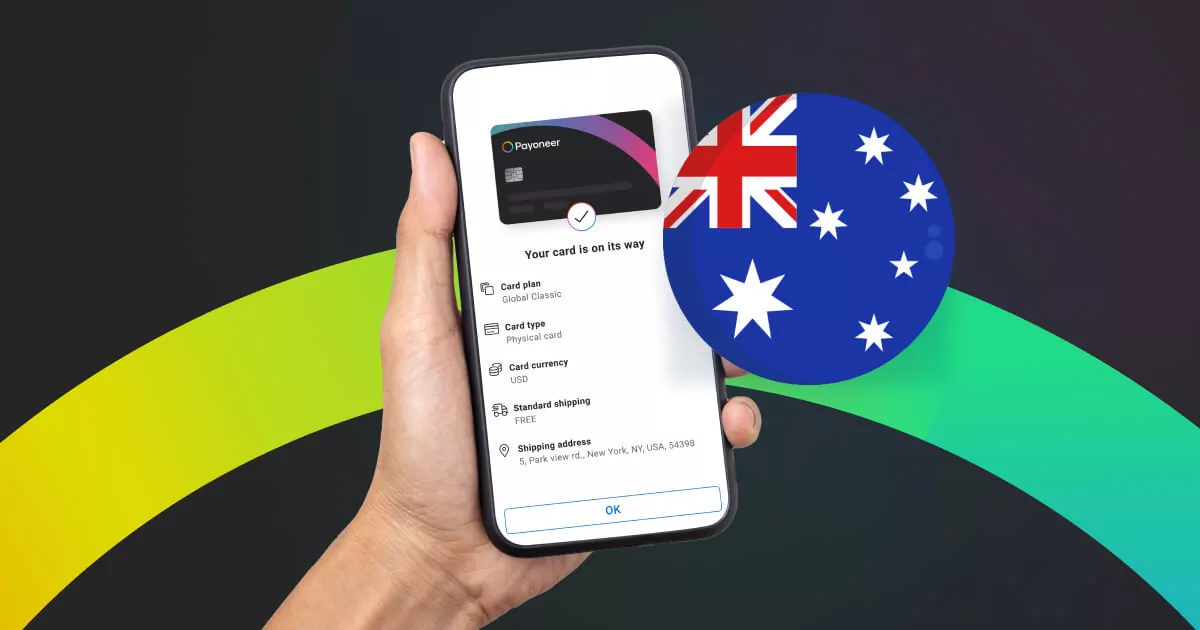HomeResourcesGeneral PaymentsOnline Banking
How To Open A Bank Account in Australia Online for Your Business
Australia’s eCommerce market is booming, but receiving payments as a foreign business can be complicated due to complex banking regulations. This article provides alternative options and approaches to simplify the process, allowing you to receive payments in local currency with transparent and reasonable pricing.

What is needed to open an Australian bank account for a business?
Australia is a huge market, with eCommerce leading the growth trend. By 2021 eCommerce sales are anticipated to reach $2.3 trillion, performing alongside global powerhouses like China, the US, and the UK. Aussie shoppers love doing business online, with the percentage of customers purchasing online is showing consistent growth year over year.
To get a foothold in Australia, it’s important to know how to set up receiving payments as a foreign business. The traditional process is to open an Australian business account at a bank. Payments into a business account are performed by wire transfer, cheque, or direct deposit. But what is needed to do this as a foreign business entity? Moving into new markets can be complicated, read the ins and outs of Australian business banking for foreigners to get the full picture of the process.
What is needed to open a business account in Australia?
Foreign companies cannot open a business bank account in Australia without having a local presence, which means registering an Australian branch or division with the Australian Securities and Investments Commission (ASIC) before being able to apply for a business account at any bank. To maintain the company’s status, foreign businesses must maintain a registered office in Australia with regular hours of operation and a brick and mortar office address that matches the ACN. In addition, the office must be staffed by a company representative during hours of operation. For a completely online small business, eCommerce seller, or freelancer, this is a hefty requirement.
Once you have registered your company, including assigning a local representative, you can choose an a bank and apply for an AUD company bank account.
In order to process your request you will have to present several documents at the bank:
Australian Business Number (ABN) or Australian Company Number (ACN) attached to a local address
A certificate of business registration will be required by the bank in order to open a business account
Documents demonstrating that shareholders with more than 25% holding meet a minimum threshold of ‘points’ (this basically means that you have to show that an approved company representative or major shareholder is an Australian resident)
Australian banks will allow you to apply online for a company bank account and then present the necessary documentation in person at a later time. However, you will still be required to appear in person or assign a legally recognized representative to act on your behalf.
What is the points system for opening an Australian bank account?
In order to open a bank account or to register a business, you’ll either need to live in Australia or you will need a resident of Australia to act on behalf of the company and present a number of documents. It is fairly complicated to open a bank account as a foreign company in Australia. The requirements make it difficult for smaller global companies, eCommerce sellers, freelancers to open a bank checking account for receiving payments from your Australian customers.
Each kind of identifying document requested by Australian banks is allocated a set number of points. In order to be approved, the total number of points accrued with the documents must total 100. The necessary documents and associated points are listed in the table.
Which Australian banks should you contact?
Australia’s banking landscape is dominated by four major banks:
- Commonwealth Bank of Australia
- Westpac Banking Corporation
- Australia and New Zealand Banking Group
- National Australia Bank
While there are several smaller banks and other financial institutions that provide limited banking services, including receiving payments, these four main banks are where the majority of businesses keep their accounts. Many large global banks also have branches in Australia, so you can check to see if there are branches of your bank and inquire about opening a business account. The regulations for companies are the same regardless of whether it is an international bank, so expect to present the same documents in order to apply and verify for a business checking account.
Transferring money to your home account
Once you have a business bank account in Australia, you will be able to receive and issue payments. Often these transactions can be done online. Virtual banking is making international business more accessible and straightforward, however, it is important to understand what the process and potential costs are before transferring money in and out of an Australian company account.
To transfer money from your account abroad or receive international money transfers, you or the sender will need the following details:
Bank name.
BIC/SWIFT code. BIC stands for Bank Identifier Code, sometimes called SWIFT. This 8-11 digit code identifies a bank to make sure money is being transferred to the right place.
BSB (bank, state, branch) and bank account number. You can find this information in your online business banking profile.
Recipient’s full name and registered street address.
Note: Australian banks don’t use IBAN codes – these are predominantly used for money transfers in Europe. But, BIC/SWIFT codes are used globally.
Be aware that banks charge hefty fees for receiving and transferring funds to and from overseas accounts. It is important to check the specific rates and guidelines at your chosen bank before moving money around as these costs may be prohibitive. An additional fee may be levied by the foreign bank as well, driving up the cost of doing business as a foreign company in Australia. Another important thing to check regarding bank transfers and receiving payments is currency rates – often banks give less favourable exchange rates in lieu of hefty fees.global payment solutions!
Alternative to business banking accounts in Australia
Australia’s business banking regulations make it tricky to receive payment to a local account. The process of meeting the requirements for a company account is complex, lengthy, and costly. Furthermore, once you have an established account, transferring funds in and out of your account may be associated with fees and delays.
Although online banking is making global business more accessible, it may not be the right choice for eCommerce sellers, global freelancers, and other virtually-operating professionals and online business. Between the red tape, fees, and delays, it may not makes sense for foreign entrepreneurs to pursue opening an Australian business account to receive payments locally in AUD. So what’s the alternative?
Payoneer offers multi-currency accounts that allow you to get paid like a local in countries around the world, including in Australia. Payoneer operates on a transparent and reasonable per transaction price, so that you always know what your costs will be – unlike traditional money transfer methods that may have varying fees associated. With numerous features and benefits, including fully online application and account management, Payoneer simplifies successful expansions.
Related resources
Latest articles
-
Made in India for the World: The State of Indian Cross-Border eCommerce
The Indian eCommerce market has grown significantly in the last few years. As a result, many cross-border businesses have undergone a fast-paced digital transformation and contributed to surpassing the government-set $400 billion target of trade within a single year.
-
Defying the odds: How Ukrainian businesses thrive during war
One year post-war, Ukraine’s businesses adapt and thrive amidst adversity. Entrepreneurs showcase resilience, reflecting national tenacity. Many diversify, venturing into e-commerce and digital realms. Despite hurdles, 44% of SMBs aim for growth, with 36% hiring. Their grit underscores Ukraine’s enduring spirit amid challenges.
-
An 8-point Checklist for Finding the Best Payment Provider
There’s huge potential to expand into ASEAN markets. But only for online sellers that accept local payment methods. Finding a trusted payment solution can be a worry and a challenge. Use this checklist to vet potential payment partners. With the right payment support, the sky’s the limit!
-
How to bill your international clients
Want to learn how to bill international clients when you’re based in the Philippines? In this article we spoke to three leading business owners who shared their tips to working successful international work. Learn how they collect payments and more below.
-
How to nail your direct-to-consumer payment strategy
Asia-Pacific offers massive potential for DTC ecommerce. But cross-border payments can be a headache. We share an actionable strategy for DTC payments that’ll remove DTC payment hazards and expand your business with ease. What are you waiting for?
-
How to pay international vendors in order to promote profits and reduce risk
In this article, we’ll share our expert tips and best practices for paying international vendors, so you can focus on growing your business. From choosing the right payment method to navigating currency exchange, we’ve got you covered.














